check engine VOLVO V70 1999 Owners Manual
[x] Cancel search | Manufacturer: VOLVO, Model Year: 1999, Model line: V70, Model: VOLVO V70 1999Pages: 61, PDF Size: 0.88 MB
Page 2 of 61

In production, Volvo has partly or completely phased out several chemicals including freons, lead chromates,
naphtanates, asbestos, mercury and cadmium; and reduced the amount of chemicals used in our plants 50% since 1991.
In use, Volvo was the first in the world to introduce into production a three-way catalytic converter with a Lambda
sond, now called oxygen sensor, in 1976. The current version of this highly efficient system reduces emissions of
harmful substances (CO, HC, NOx) from the exhaust pipe by approximately 95% and the search to eliminate the
remaining emissions continues. Volvo is the only automobile manufacturer to offer CFC-free retrofit kits for the air
conditioning system for all models back to the M/Y 1975 240. Advanced electronic engine controls, refined
purification systems and cleaner fuels are bringing us closer to our goal.
After Volvo cars and parts have fulfilled their use, recycling is the next critical step in completing the life cycle. The
metal content is about 75% of the total weight of the car, which makes the car among the most recycled industrial
products. In order to have efficient and well controlled recycling, many Volvo variants have printed dismantling
manuals indication the weight and material of individual components. For Volvo, all homogeneous plastic parts
weighing more than 1.7 oz. (50 grams)are marked with international symbols that indicate how the component is to be
sorted for recycling.
In addition to continuous environmental refinement of conventional gasoline-powered internal combustion engines,
Volvo is actively looking at advanced technology alternative-fuel vehicles.
When you drive a Volvo, you become our partner in the work to lessen the car's impact on the environment. To reduce
your vehicle's environmental impact, you can:
Maintain proper air pressure in your tires. Tests have shown decreased fuel economy with improperly inflated
tires Follow the recommended maintenance schedule
Drive at a constant speed
See an authorized Volvo retailer as soon as possible for inspection if the check engine (malfunction indicator)
lamp illuminates, or stays on after the vehicle has started
Properly dispose of any vehicle related waste such as used motor oil, used batteries, brake pads, etc.
When cleaning your car, use Volvo's own car care products, all of which have systematically been adapted to
the environment.
Contents
Table of Contents
Page No.
Chapter and Subject
pg. 1Chapter 1 - Occupant safety
pg. 16
Chapter 2 - Instruments and controls
pg. 41
Chapter 3 - Body and interior
pg. 65
Chapter 4 - Starting and driving
pg. 85
Chapter 5 - Wheels and tires
pg. 91
Chapter 6 - In case of emergency
pg. 109
Chapter 7 - Car care
pg. 115
Chapter 8 - Volvo Service
ProCarManuals.com
Page 14 of 61

Turn the key once to unlock the driver's door only.
Turn the key again (within 10 seconds) to unlock all doors, trunk/tailgate.
One turn with the key towards lock in the drivers door locks all doors, trunk/tailgate.
Use the switch on the front door armrests to lock/unlock the car from the inside.
Check the action of the buttons on the other doors to verify their correct function (lock/unlock).WARNING! The doors should not be locked while driving. In case of an accident, this may hinder rapid access to
the occupants of the vehicle. (Also see information on "Child safety locks".)
Central locking button (on both front doors)
Central locking button
The central locking buttons on both front door armrests can be used to lock or unlock all doors and trunk/tailgate and
set the alram if your car is so equipped. This switch functions even if a door/trunk/tailgate is open.
Lock: Press the left side of the button
Unlock: Press the right side of the button
NOTE: To help prevent accidentally locking the keys in the car, the central locking system is designed to unlock the
driver's door immediately if the key is left in the ignition switch and the car is locked using the lock button on the
door. A sound from the lock will be audible at this time.
Please note that this function will not unlock the doors if the engine is running. pg. 44 Remote keyless entry system
ProCarManuals.com
Page 17 of 61
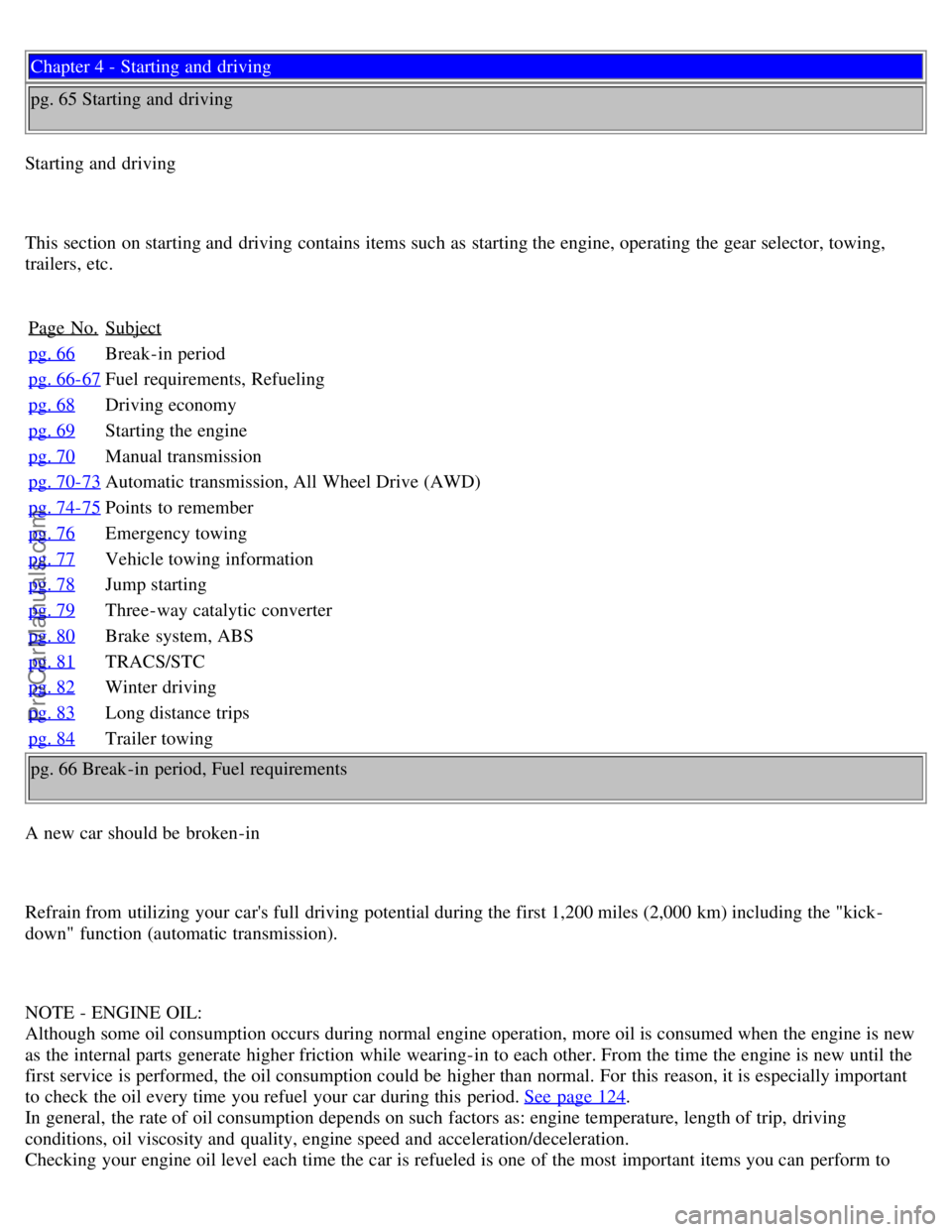
Chapter 4 - Starting and driving
pg. 65 Starting and driving
Starting and driving
This section on starting and driving contains items such as starting the engine, operating the gear selector, towing,
trailers, etc. Page No.
Subject
pg. 66Break-in period
pg. 66-67
Fuel requirements, Refueling
pg. 68
Driving economy
pg. 69
Starting the engine
pg. 70
Manual transmission
pg. 70-73
Automatic transmission, All Wheel Drive (AWD)
pg. 74-75
Points to remember
pg. 76
Emergency towing
pg. 77
Vehicle towing information
pg. 78
Jump starting
pg. 79
Three-way catalytic converter
pg. 80
Brake system, ABS
pg. 81
TRACS/STC
pg. 82
Winter driving
pg. 83
Long distance trips
pg. 84
Trailer towing
pg. 66 Break-in period, Fuel requirements
A new car should be broken-in
Refrain from utilizing your car's full driving potential during the first 1,200 miles (2,000 km) including the "kick -
down" function (automatic transmission).
NOTE - ENGINE OIL:
Although some oil consumption occurs during normal engine operation, more oil is consumed when the engine is new
as the internal parts generate higher friction while wearing-in to each other. From the time the engine is new until the
first service is performed, the oil consumption could be higher than normal. For this reason, it is especially important
to check the oil every time you refuel your car during this period. See page 124
.
In general, the rate of oil consumption depends on such factors as: engine temperature, length of trip, driving
conditions, oil viscosity and quality, engine speed and acceleration/deceleration.
Checking your engine oil level each time the car is refueled is one of the most important items you can perform to
ProCarManuals.com
Page 19 of 61
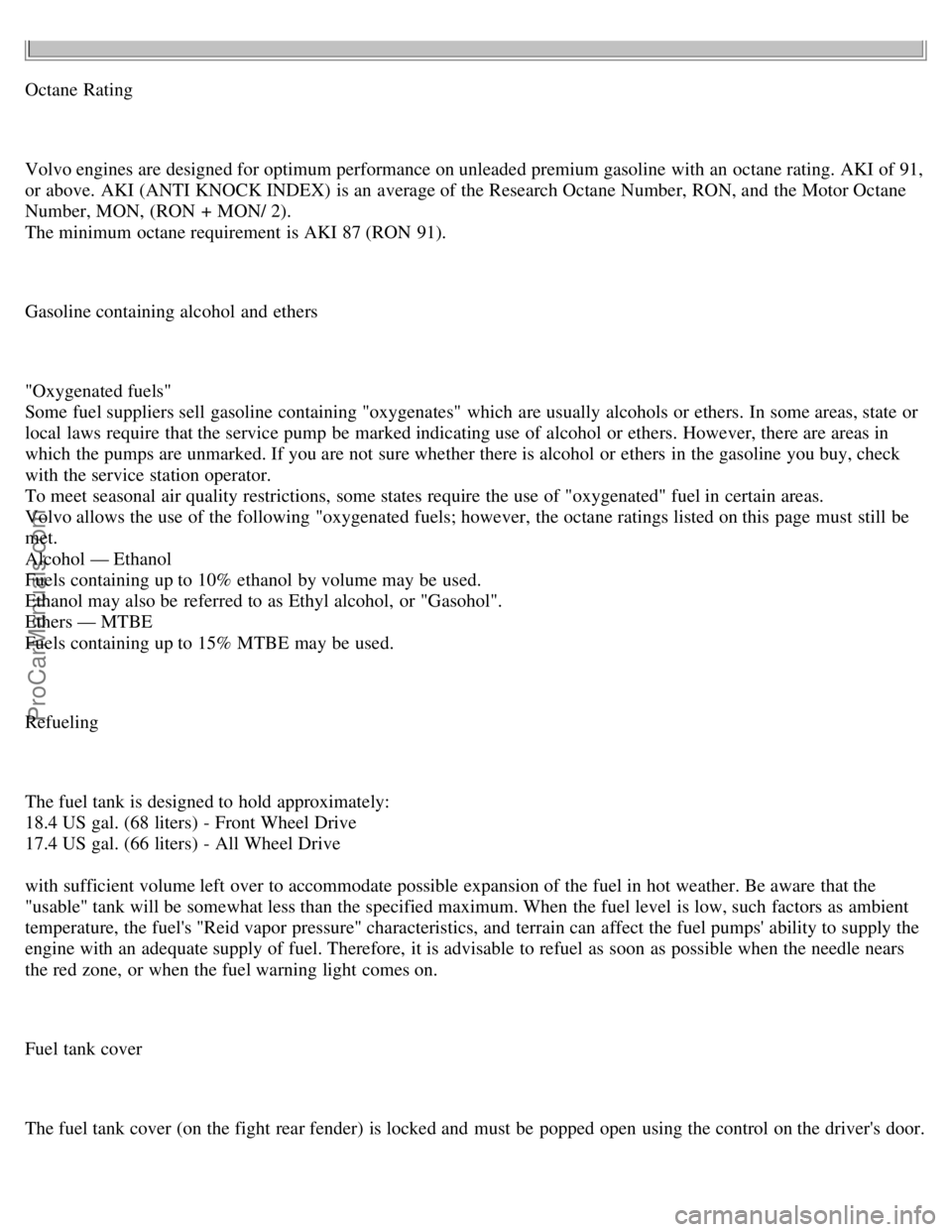
Octane Rating
Volvo engines are designed for optimum performance on unleaded premium gasoline with an octane rating. AKI of 91,
or above. AKI (ANTI KNOCK INDEX) is an average of the Research Octane Number, RON, and the Motor Octane
Number, MON, (RON + MON/ 2).
The minimum octane requirement is AKI 87 (RON 91).
Gasoline containing alcohol and ethers
"Oxygenated fuels"
Some fuel suppliers sell gasoline containing "oxygenates" which are usually alcohols or ethers. In some areas, state or
local laws require that the service pump be marked indicating use of alcohol or ethers. However, there are areas in
which the pumps are unmarked. If you are not sure whether there is alcohol or ethers in the gasoline you buy, check
with the service station operator.
To meet seasonal air quality restrictions, some states require the use of "oxygenated" fuel in certain areas.
Volvo allows the use of the following "oxygenated fuels; however, the octane ratings listed on this page must still be
met.
Alcohol — Ethanol
Fuels containing up to 10% ethanol by volume may be used.
Ethanol may also be referred to as Ethyl alcohol, or "Gasohol".
Ethers — MTBE
Fuels containing up to 15% MTBE may be used.
Refueling
The fuel tank is designed to hold approximately:
18.4 US gal. (68 liters) - Front Wheel Drive
17.4 US gal. (66 liters) - All Wheel Drive
with sufficient volume left over to accommodate possible expansion of the fuel in hot weather. Be aware that the
"usable" tank will be somewhat less than the specified maximum. When the fuel level is low, such factors as ambient
temperature, the fuel's "Reid vapor pressure" characteristics, and terrain can affect the fuel pumps' ability to supply the
engine with an adequate supply of fuel. Therefore, it is advisable to refuel as soon as possible when the needle nears
the red zone, or when the fuel warning light comes on.
Fuel tank cover
The fuel tank cover (on the fight rear fender) is locked and must be popped open using the control on the driver's door.
ProCarManuals.com
Page 20 of 61

Open fuel filler cap slowly during hot eather conditions.
CAUTION:
Do not refuel with the engine running. Turn the ignition off or to position I. If the ignition is on, an incorrect
reading could occur in the fuel gauge.
Allow for fuel expansion by not overfilling the tank. Overfilling could also cause damage to the emission control
systems.
Avoid spilling gasoline during refueling. Gasolines containing alcohol can cause damage to painted surfaces,
which may not be covered under the New Vehicle Limited Warranty.
Do not use gasoline containing methanol (methyl alcohol, wood alcohol). This practice can result in vehicle
performance deterioration and can damage critical parts in the fuel system. Such damage may not be covered under
the New Vehicle LimitedWarranty.
* If the fuel filler cap is not closed tightly or if the engine is running when the car is refueled, the Malfunction
Indicator Lamp may indicate a fault. However, your vehicle's performance will not be affected. Use only Volvo
original or approved fuel filler caps. pg. 68 Driving economy
Economical driving conserves natural resources
Better driving economy may be obtained by thinking ahead, avoiding rapid starts and stops and adjusting the speed of
your vehicle to immediate traffic conditions. Observe the following rules:
Bring the engine to normal operating temperature as soon as possible by driving with a light foot on the accelerator
pedal for the first few minutes of operation. A cold engine uses more fuel and is subject to increased wear.
Whenever possible, avoid using the car for driving short distances. This does not allow the engine to reach normal
operating temperature.
Drive carefully and avoid rapid acceleration and hard braking.
Do not exceed posted speed limit.
Avoid carrying unnecessary items (extra load) in the car.
Maintain correct tire pressure. Check tire pressure regularly (check when tires are cold).
Remove snow tires when threat of snow or ice has ended.
Note that roof racks, ski racks, etc., increase air resistance and thereby fuel consumption.
Avoid using automatic transmission kick-down feature unless necessary.
Avoid using the air conditioning when it is not required. When engaged, the air conditioner's compressor places an
additional load on the engine. However, please note that fuel consumption is lower with the air conditioning on than it
is when driving with the air conditioning switched off and the windows down.
If your car is equipped with the optional Trip Computer, utilizing the fuel consumption modes can help you "learn"
how to drive more economically.
Other factors which decrease gas mileage are:
Worn or dirty spark plugs
ProCarManuals.com
Page 21 of 61
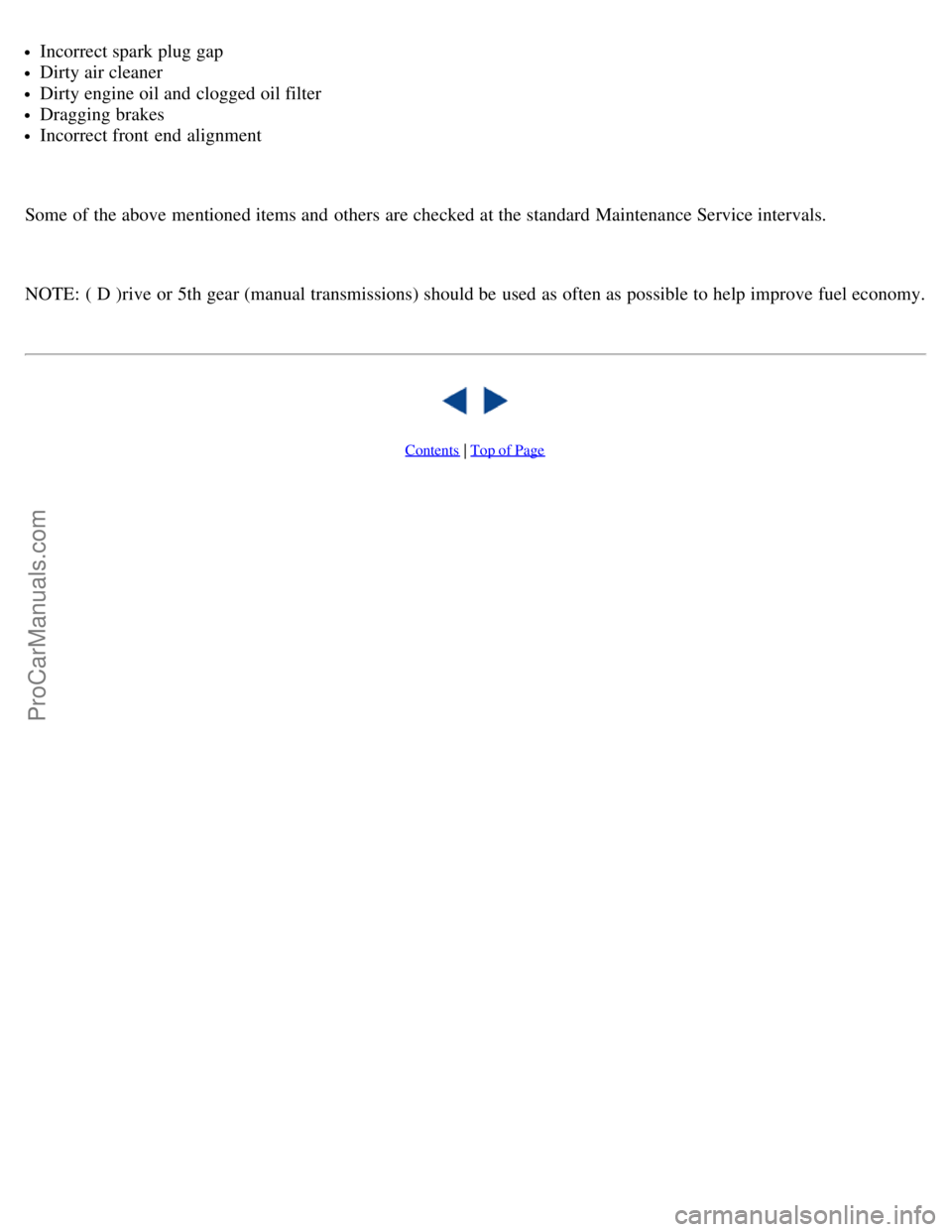
Incorrect spark plug gap
Dirty air cleaner
Dirty engine oil and clogged oil filter
Dragging brakes
Incorrect front end alignment
Some of the above mentioned items and others are checked at the standard Maintenance Service intervals.
NOTE: ( D )rive or 5th gear (manual transmissions) should be used as often as possible to help improve fuel economy.
Contents | Top of Page
ProCarManuals.com
Page 32 of 61
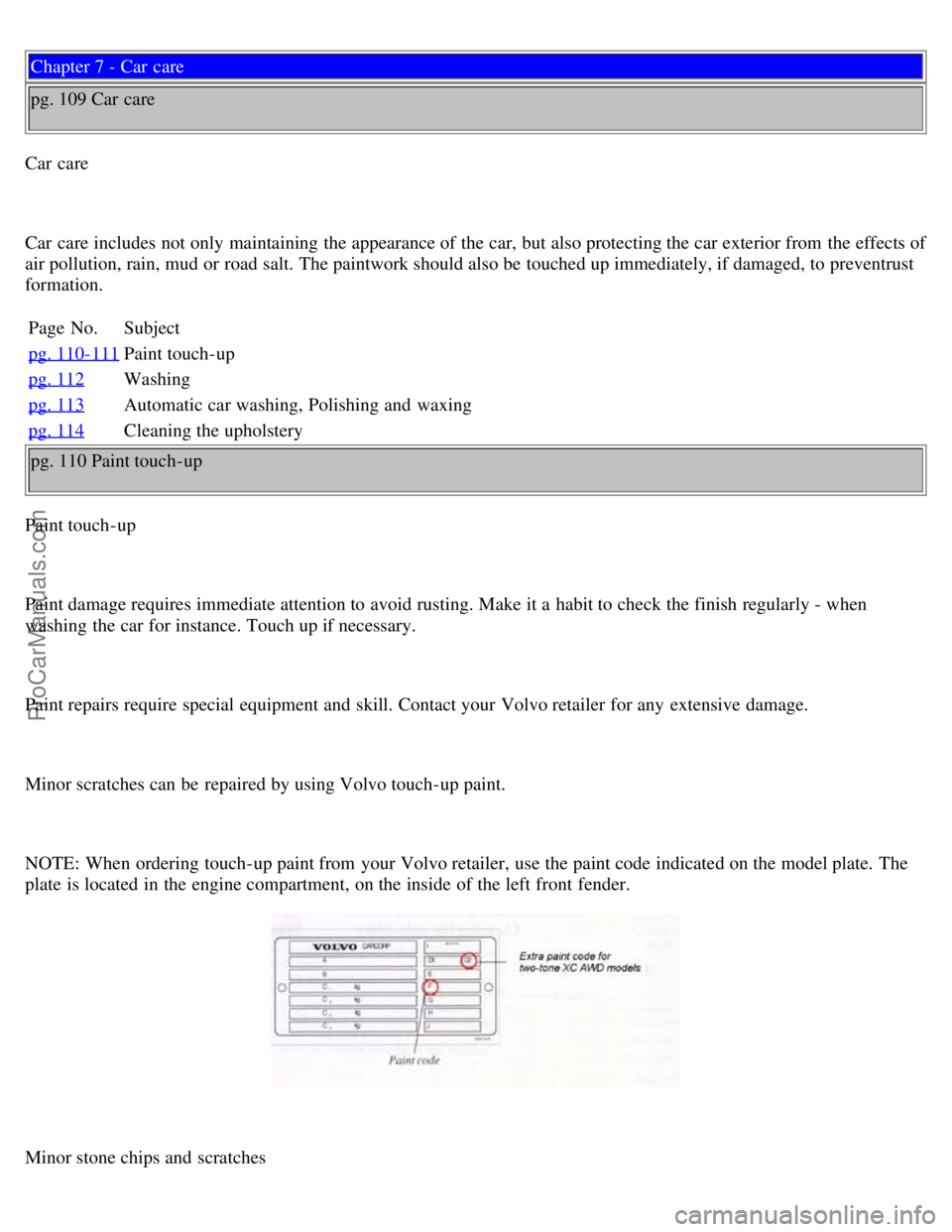
Chapter 7 - Car care
pg. 109 Car care
Car care
Car care includes not only maintaining the appearance of the car, but also protecting the car exterior from the effects of
air pollution, rain, mud or road salt. The paintwork should also be touched up immediately, if damaged, to preventrust
formation. Page No. Subject
pg. 110-111
Paint touch-up
pg. 112
Washing
pg. 113
Automatic car washing, Polishing and waxing
pg. 114
Cleaning the upholstery
pg. 110 Paint touch-up
Paint touch-up
Paint damage requires immediate attention to avoid rusting. Make it a habit to check the finish regularly - when
washing the car for instance. Touch up if necessary.
Paint repairs require special equipment and skill. Contact your Volvo retailer for any extensive damage.
Minor scratches can be repaired by using Volvo touch-up paint.
NOTE: When ordering touch-up paint from your Volvo retailer, use the paint code indicated on the model plate. The
plate is located in the engine compartment, on the inside of the left front fender.
Minor stone chips and scratches
ProCarManuals.com
Page 41 of 61
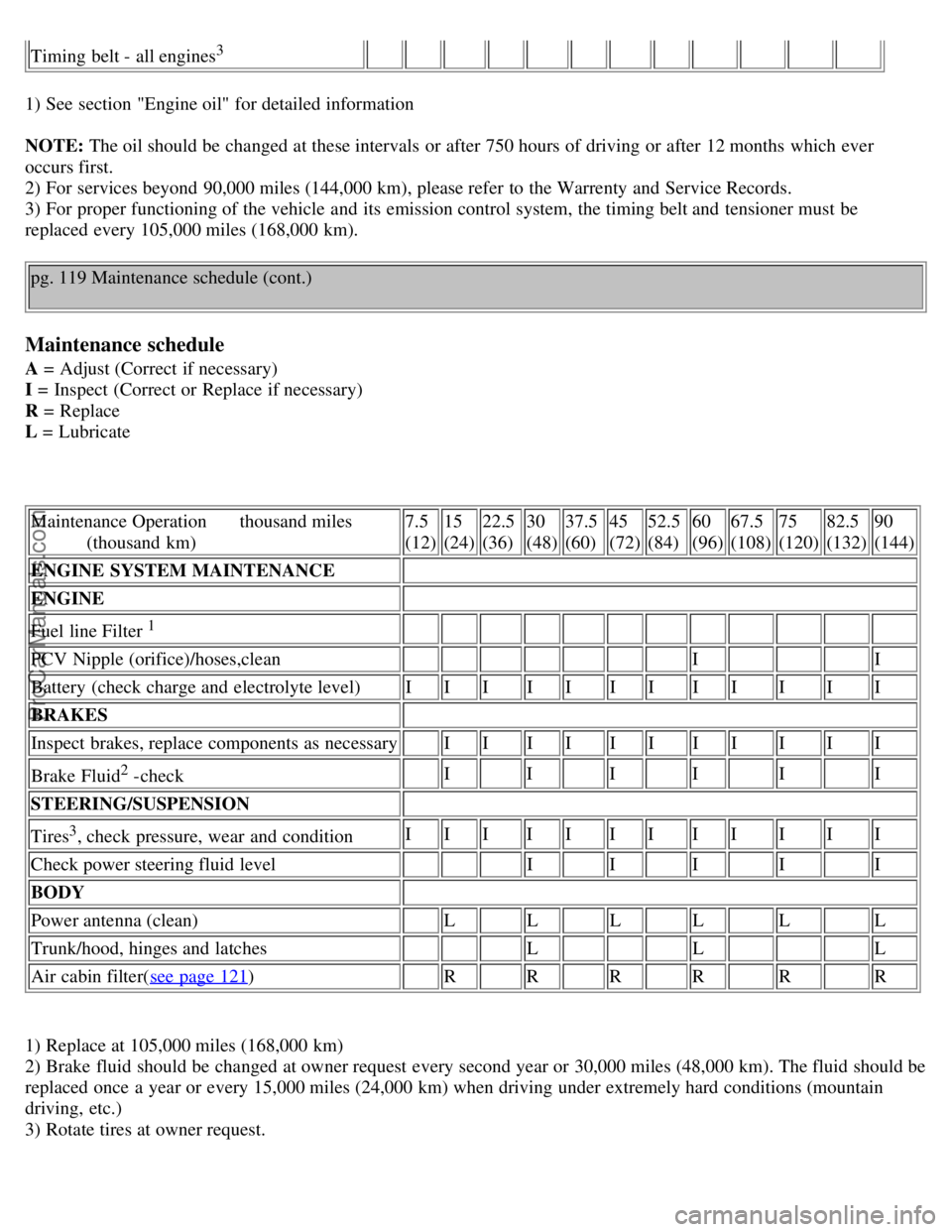
Timing belt - all engines3
1) See section "Engine oil" for detailed information
NOTE: The oil should be changed at these intervals or after 750 hours of driving or after 12 months which ever
occurs first.
2) For services beyond 90,000 miles (144,000 km), please refer to the Warrenty and Service Records.
3) For proper functioning of the vehicle and its emission control system, the timing belt and tensioner must be
replaced every 105,000 miles (168,000 km).
pg. 119 Maintenance schedule (cont.)
Maintenance schedule
A = Adjust (Correct if necessary)
I = Inspect (Correct or Replace if necessary)
R = Replace
L = Lubricate
Maintenance Operation thousand miles
(thousand km) 7.5
(12)15
(24)22.5
(36) 30
(48)37.5
(60) 45
(72)52.5
(84) 60
(96)67.5
(108) 75
(120)82.5
(132)90
(144)
ENGINE SYSTEM MAINTENANCE
ENGINE
Fuel line Filter
1
PCV Nipple (orifice)/hoses,clean I I
Battery (check charge and electrolyte level) III II II II III
BRAKES
Inspect brakes, replace components as necessary II II II II III
Brake Fluid
2 -check
I I I I I I
STEERING/SUSPENSION
Tires
3, check pressure, wear and condition I
II II II II III
Check power steering fluid level I I I I I
BODY
Power antenna (clean) L L L L L L
Trunk/hood, hinges and latches L L L
Air cabin filter( see page 121
) R R R R R R
1) Replace at 105,000 miles (168,000 km)
2) Brake fluid should be changed at owner request every second year or 30,000 miles (48,000 km). The fluid should be
replaced once a year or every 15,000 miles (24,000 km) when driving under extremely hard conditions (mountain
driving, etc.)
3) Rotate tires at owner request.
ProCarManuals.com
Page 42 of 61
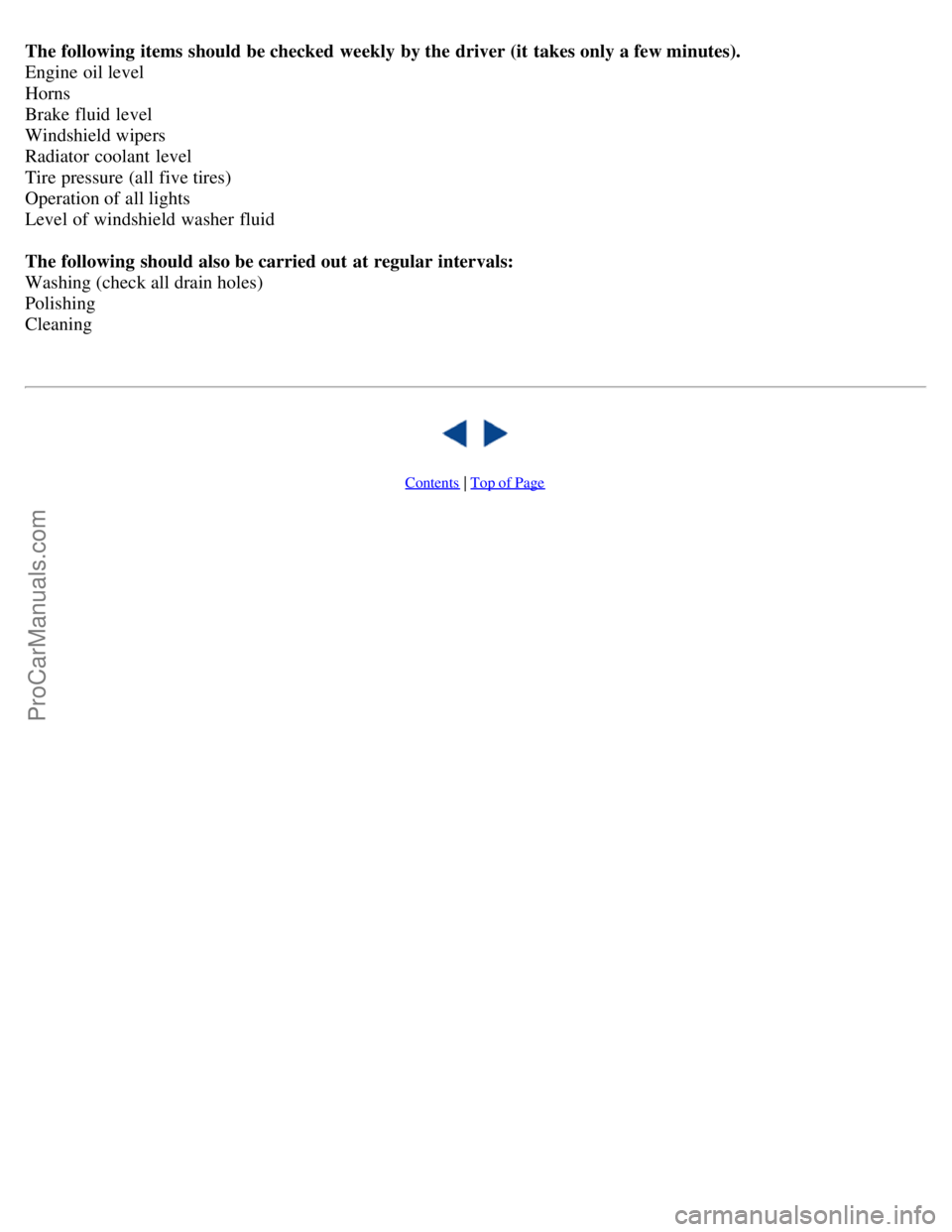
The following items should be checked weekly by the driver (it takes only a few minutes).
Engine oil level
Horns
Brake fluid level
Windshield wipers
Radiator coolant level
Tire pressure (all five tires)
Operation of all lights
Level of windshield washer fluid
The following should also be carried out at regular intervals:
Washing (check all drain holes)
Polishing
Cleaning
Contents | Top of Page
ProCarManuals.com
Page 46 of 61
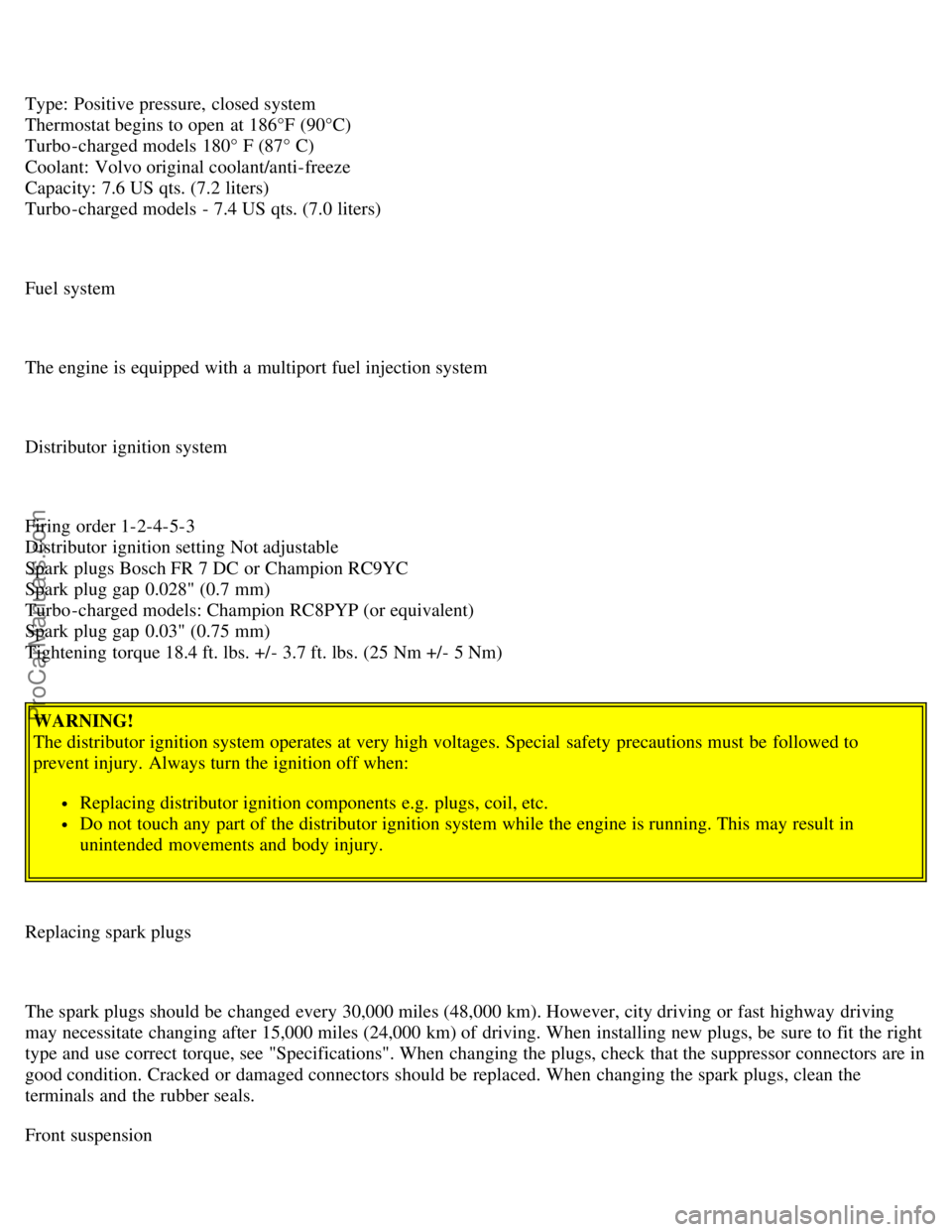
Type: Positive pressure, closed system
Thermostat begins to open at 186°F (90°C)
Turbo -charged models 180° F (87° C)
Coolant: Volvo original coolant/anti-freeze
Capacity: 7.6 US qts. (7.2 liters)
Turbo -charged models - 7.4 US qts. (7.0 liters)
Fuel system
The engine is equipped with a multiport fuel injection system
Distributor ignition system
Firing order 1-2-4-5-3
Distributor ignition setting Not adjustable
Spark plugs Bosch FR 7 DC or Champion RC9YC
Spark plug gap 0.028" (0.7 mm)
Turbo -charged models: Champion RC8PYP (or equivalent)
Spark plug gap 0.03" (0.75 mm)
Tightening torque 18.4 ft. lbs. +/- 3.7 ft. lbs. (25 Nm +/- 5 Nm)WARNING!
The distributor ignition system operates at very high voltages. Special safety precautions must be followed to
prevent injury. Always turn the ignition off when:
Replacing distributor ignition components e.g. plugs, coil, etc.
Do not touch any part of the distributor ignition system while the engine is running. This may result in
unintended movements and body injury.
Replacing spark plugs
The spark plugs should be changed every 30,000 miles (48,000 km). However, city driving or fast highway driving
may necessitate changing after 15,000 miles (24,000 km) of driving. When installing new plugs, be sure to fit the right
type and use correct torque, see "Specifications". When changing the plugs, check that the suppressor connectors are in
good condition. Cracked or damaged connectors should be replaced. When changing the spark plugs, clean the
terminals and the rubber seals.
Front suspension
ProCarManuals.com